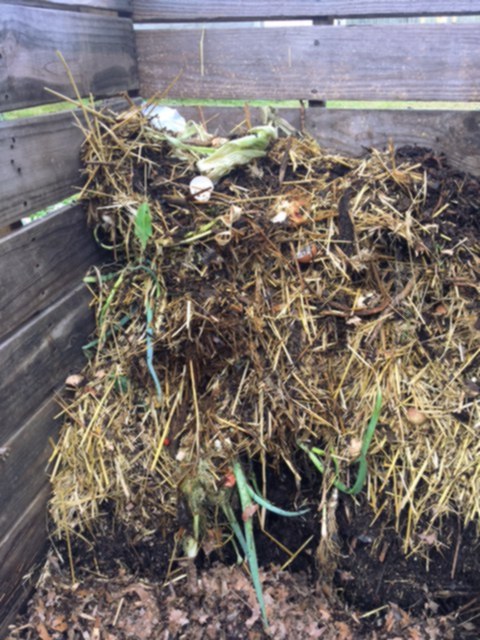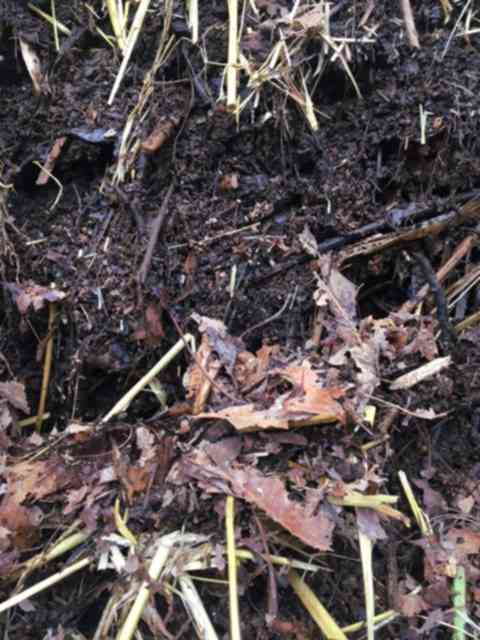← The Journal
Composting 101
Turning food and yard waste into biologically-rich soil is the cornerstone of any successful garden. When managed properly a pile of waste can become a bustling ecosystem of bacteria, fungi, and countless organisms decomposing the material into dark rich humus (pronounced "hoomus" not "hummus"). All of these organisms feed on the decomposing matter which in turn provides them with the energy they need to live and reproduce, and thus it is a world in and of itself! Composting is essentially taking the beautiful, naturally occuring design system and placing it in a controlled environment that we can then distribute wherever we believe it is needed. This process allows us to nourish our gardens, trees, shrubs, and flowers while eliminating the loss of nutrients and wasted fuel hauling the material away to a municipal landfill or other such center.
The Art of Making Compost
A compost pile only works as well as its microbes! In order for decomposition to occur the microbes need carbon, nitrogen, moisture, oxygen and warmth all in balance with one another. Let's look at each of these things:
Carbon & Nitrogen

Carbon examples
- Paper and cardboard
- Straw or hay
- Brown leaves
- Woodchips or natural mulch (in my experience, these as the primary carbon source lead to the most productive compost piles)
Nitrogen examples
- Fruits and vegetables
- Plant matter (leaves, stems)
- Coffee grounds
- Grass clippings
- Manure
Each of these things can have their own varying degrees of C:N which can make calculating exact ratios difficult. Truthfully, after you do it for awhile you just get a sense for the pile and what it needs. When starting off it's helpful to refer to a guide like this UKY Home Composting Guide (table 2) while you get the hang of it. However, don't be afraid of making mistakes and figuring it out as you go. One day you'll realize that managing your compost bin is second nature to you. My brother-in-law onced explained the composting requirements of carbon to nitrogen through the relationship seen in a living tree - leaves in relation to wood which is generally around 30:1. It perfectly illustrates the ratio needed for composting. Every tree is different, but so is everything you put into a compost pile. This simple explanation is a good way to gain a basic understanding.
Do not add meat, oils, dairy, fat, bone, human, or pet feces to your home composting pile. Doing so not only attracts rodents and other pests but also has the potential to transmit zoonotic disease.
Moisture
As is the case with any living thing, microbes also require access to moisture in order to thrive. While flooding or standing water can lead to anaerobic conditions (and foul odors!), you do want to maintain some moisture in your pile. Sometimes the food waste we add will contain moisture (most fruits, for example), but the majority of time we'll need to add more - either through manually or through rainfall. Ideally the pile will contain around 40-60% moisture, or expel about 2 drops of water when squeezed by hand. To keep water in during dry spells and keep flooding out during wet spells I cover my pile with plastic that I can easily pull on or off when starting a new pile. Once it is well established I generally cover it with a thick layer of straw, hay, or cardboard instead of plastic because I know the drainage is adequate at this size. This method works for me because of the way my bin is built which allows air to flow through the sides at all times. You'll get a sense for how to manage your pile for your environment as you gain experience with it.
Oxygen
As previously mentioned a flooded compost pile leads to anaerobic conditions where oxygen is no longer present. This will quickly make your compost pile gross. It will have an unshakeable stench and attract creatures great and small that love this kind of thing. To avoid this rather unpleasant scenario, keep your pile oxygenated by making a habit of turning it regularly. Using a pitchfork, pull from the bottom of the pile and place it on top. Not only will this add oxygen but it will redistribute the colony of microorganisms from the center of the pile to the top where most newly added material is. Every time you turn the pile you're going to lose some heat that has built up, therefore it is not necessary to turn the pile every time you add to it. It is however extremely important to turn it after a heavy rain as it will likely be depleted of oxygen, which will grind decomposition to a halt.
Interestingly when anaerobic conditions are managed intentionally they can be quite useful, such as with silage and haylage.
Heat
A compost pile heats up in two ways: through the environment and through microbiological activity. However, in order for microbes to kick into gear they need some degree of warmth to start with, therefore they're far more active during warm seasons than cold. Adding nitrogen to the pile will add heat through the winter, but don't expect the same speed of decomposition as in summer. Maintained heat in the pile is a result of the microbial activity properly decomposing the material it has been given, but it is also influenced by pile size. Small piles have a harder time holding heat whereas large piles don't move oxygen as easily. Temperature management is an important aspect of composting waste safely and correctly. A composting thermometer is a useful tool for tracking the pile's heat across the seasons. For example, a pile that is 3' × 3' × 3' can reach temperatures around 140 to 160°F (see source).
Piles, Bins, Tumblers... OH MY!
There are so many marketed ways to compost these days. Personally, I prefer the less-is-more approach that doesn't involve purchasing any gadgets or gizmos that will eventually wind up in the landfill. It seems counterintuitive to compost in plastic to me, but if this appeals to you there is an entire market of products awaiting your transaction. My personal preference is to build bins using heat treated (stamped HT) wooden pallets that would otherwise be discarded. The open slats let air flow around the pile while still holding it in a neat pile. I also really love Eliot Coleman's straw bale composting method and look forward to trying that design one day. And I've witnessed great success with sheet mulching, where carbon and nitrogen is simply layered in place as a method for making new garden beds. Each of these come with their own sets of management questions and required skill. Pick one and give it a go for a season or two then try another. The compost pile is your ... oyster?
Starting Your First Pile
No matter which bin type you choose the pile starts with the same basic principles:
- Create a base. I like a stack of artfully arranged sticks. The goal here is to create some space for air to get under the pile. (skip if using a tumbler).
- Gather carbon. This could be a pile of mulch, a pile of brown leaves, shredded cardboard, or an old hay bale.
- Add nitrogen. Everyone's favorite part. Toss on some kitchen scraps, grass clippings, or stop by Starbucks (or fave local coffee shop) and ask for coffee grounds.
- Add water. Ideally non-chlorinated but just use whatever you have. Don't swamp it.
- Kickstart with microbes. This can be done by adding some garden soil, Lactic Acid Bacteria, or worm castings or leachate.

Harvesting and Use
The rule of thumb I was taught, and have found to be generally accurate, is to spend one year building the pile and one year aging the pile. There are some exceptions to this and the more piles I make the better I get at managing it and the faster I get to a finished product. The point here is that it won't be as quick as you probably think it will be. Chin up though, it is very much worth the wait because harvesting your very first pile of dark rich humus is a pretty special day.
When the pile is about 3' tall and is more than three-fourths decomposed I stop adding new material. With the majority of materials decomposed I start harvesting from the bottom for use in the garden. Things like eggshells and stems or sticks likely won't have fully decomposed so a screen can be useful to separate them from the final product if desired. A screen is easy to make with a wooden frame and hardware cloth - it doesn't need to be anything fancy. You can apply the compost directly to the garden or mix it with non-chlorinated water for a compost brew that can be poured or sprayed onto the garden. A brew like this is a helpful way to make a small amount of compost go further. A brew is similar to the compost tea, but it doesn't include the addition of oxygen. Adding oxygen and making a true compost tea super boosts the microbiological activity which has a host of benefits to the soil it's applied to, but it's not an absolute requirement for using it in liquid form.
